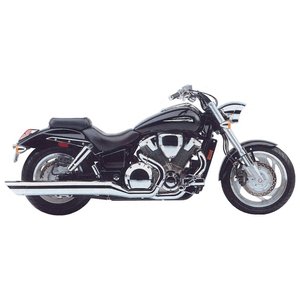Honda VTX 1800 R [2002–2007]: A Timeless Power Cruiser Revisited
Introduction
When Honda unleashed the VTX 1800 R in 2002, it wasn’t just launching another cruiser—it was making a statement. With its colossal 1,795cc engine, muscular proportions, and unapologetic focus on raw power, the VTX 1800 R became an instant icon in the "power cruiser" segment. For riders who wanted bragging rights at stoplights and a commanding presence on highways, this Honda delivered—and still does. Let’s dive into what makes this generation of the VTX 1800 R a machine worth remembering—and perhaps even owning today.
Design: Dominance on Two Wheels
The VTX 1800 R doesn’t whisper; it roars visually before you even start the engine. Its design is a masterclass in purposeful aggression. The liquid-cooled 1800cc V-twin sits front and center, framed by angular chrome covers and massive dual exhausts. The inverted front fork (a rarity for cruisers of its era) and 17-inch front wheel give it a modern stance, while the 180mm rear tire screams old-school muscle.
Color options like Dark Blue Metallic/Silver or Black/Red accentuate its curves, but even in all-black trim, this bike exudes menace. The 2007 model’s slightly reduced fuel tank (20L vs. 24L in earlier years) does little to compromise its bulldog profile. Practical touches like a low seat height (693–696 mm / 27.3–27.4 inches) make it accessible, though its 340 kg (750 lbs) dry weight reminds you this isn’t a beginner’s toy.
Engine and Performance: Torque Is the Name of the Game
Let’s address the elephant in the room: that 1795cc SOHC V-twin. With 163 Nm (120 ft.lbs) of torque peaking at just 3,000 RPM, the VTX 1800 R isn’t just powerful—it’s urgent. Throttle response from the PGM-FI fuel injection system is crisp, and the dual spark plugs per cylinder ensure efficient combustion. While its 107 HP (78 kW) might seem modest by today’s hypersport standards, it’s the torque curve that defines this bike.
Twist the throttle, and the VTX surges forward with locomotive authority. The 5-speed gearbox is smooth, though you’ll rarely need to downshift—third gear pulls from 50 km/h (31 mph) to triple digits effortlessly. The shaft drive eliminates chain maintenance and adds to the buttery power delivery, though purists might miss the visceral feedback of a chain-driven machine.
At highway speeds (110–130 km/h or 68–80 mph), the engine settles into a relaxed 2,800 RPM hum, thanks to its tall gearing. Fuel economy? Expect around 6.5–7 L/100 km (36–33 mpg), giving a range of ~280 km (174 miles) on the 20L tank. Not stellar, but forgivable given the engine’s character.
Handling: Taming the Beast
You don’t ride a 340 kg cruiser like a sportbike, but the VTX 1800 R surprises with its composure. The 45mm inverted fork and dual rear shocks (adjustable for preload) provide a plush yet controlled ride. Front suspension travel is generous at 130 mm (5.1 inches), soaking up potholes without wallowing.
Where the VTX struggles is tight corners. The 32-degree rake angle and 1,715 mm (67.5-inch) wheelbase prioritize stability over flickability. At low speeds, the weight is noticeable—parking lot maneuvers demand respect. But once rolling, the bike feels surprisingly agile for its size. The 150/80-R17 front and 180/70-R16 rear tires offer ample grip, though modern rubber could enhance confidence.
Comfort: Mile-Munching Meets Muscle
Honda nailed the ergonomics for long rides. The seat is wide and supportive, with a slight forward lean to the chrome handlebars that keeps your back relaxed. Vibration is minimal, even at higher RPMs—a testament to the engine’s counterbalancers.
Wind protection is minimal, though. Riders over 180 cm (5’11") might want an aftermarket windshield for extended highway runs. Passenger accommodations are generous, with sturdy grab rails and a well-padded pillion seat.
Competition: How the VTX Stacks Up
The early 2000s power cruiser wars were fierce. Here’s how the VTX 1800 R held its ground:
- Kawasaki Vulcan 2000 (2004–2010):
- Larger 2,053cc V-twin but softer tuning (103 Nm torque).
- Lighter at 318 kg (701 lbs) but lacked the VTX’s brutish character.
-
Chain drive required more maintenance.
-
Yamaha Road Star Warrior (2002–2007):
- 1,670cc air-cooled V-twin with sharper styling.
-
Lighter (295 kg / 650 lbs) and more agile, but down on torque (137 Nm).
-
Suzuki Boulevard M109R (2006–Present):
- 1,783cc V-twin with radical styling.
- Higher-revving (115 HP) but required aggressive riding to access torque.
The VTX 1800 R’s edge? Effortless low-end grunt and Honda’s legendary reliability. It wasn’t the flashiest, but it delivered where it counted.
Maintenance: Keeping the Legend Alive
Owners praise the VTX 1800 R’s durability, but neglect is its worst enemy. Key considerations:
- Cooling System: Flush coolant every 2 years. The liquid-cooled engine runs hot in traffic; ensure the radiator fins are debris-free.
- Shaft Drive: Change final drive oil every 24,000 km (15,000 miles). Inspect seals for leaks.
- Brakes: Dual 316mm front discs offer strong stopping power, but pads wear quickly under hard use. Upgrade to sintered pads for longevity.
- Tires: The 180/70-R16 rear is cruiser-specific; stick to recommended brands like Metzeler Cruisetec.
- Suspension: Lube the rear shock linkages annually. Adjust preload based on load—this bike sags noticeably with a passenger.
For DIYers, MOTOPARTS.store stocks OEM-spec filters, shaft drive oils, and performance exhausts to wake up that V-twin roar.
Conclusion: The Uncompromising Cruiser
The Honda VTX 1800 R isn’t a bike that asks for permission. It’s heavy, thirsty, and unapologetically old-school. But that’s precisely its charm. In an era where cruisers increasingly chase lightweight agility, the VTX remains a reminder of when "bigger is better" was a mantra, not a compromise.
Whether you’re hunting for a used gem or already own one, this Honda rewards those who respect its heft and harness its torque. And with MOTOPARTS.store’s catalog of upgrades and replacements, keeping this legend on the road is easier than ever.
Ride hard, ride safe, and let that 1800cc V-twin sing.



















